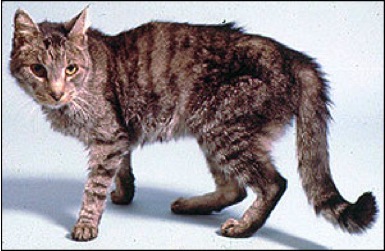The contribution of fat loss versus muscle wasting to the loss of body weight seen in hyperthyroid cats is unknown. The objective of this study was to investigate body weight, body condition score (BCS), and muscle condition score (MCS) in hyperthyroid cats.
Evaluation of Body Weight, Body Condition, and Muscle Condition in Cats with Hyperthyroidism

Four hundred sixty-two cats with untreated hyperthyroidism, 117 of which were reevaluated after treatment were used for this study.
The method used was a prospective cross-sectional and before–after studies. Untreated hyperthyroid cats had body composition evaluated (body weight, BCS, and MCS). A subset of these cats were reevaluated 3–12 months after treatment when euthyroid.
The results showed that pretreatment body weight (median, 4.36 kg; IQR, 3.5 to 5.2 kg) was lower than premorbid weight (5.45 kg; IQR, 4.6 to 6.4 kg, P < .0001) recorded 1–2 years before diagnosis. 154 (35.3%) cats were thin or emaciated; 357 (77.3%) had loss of muscle mass. Cats showed increases in body weight (median, 4.1 kg to 5.0 kg), BCS (median, 3/5 to 3.5/5), and MCS (2/3 to 3/3) after treatment (P < .001), but mild-to-moderate muscle wasting persisted in 45% of treated cats.
In conclusion most hyperthyroid cats lose body weight but maintain an ideal or overweight BCS, with only a third being underweight. As in human hyperthyroid patients, this weight loss is associated with muscle wasting, which affects >75% of hyperthyroid cats. Successful treatment leads to weight gain and increase of BCS in most cats, but almost half fail to regain normal muscle mass.
Click here to be directed to the full study in the Journal of Veterinary Internal Medicine.

